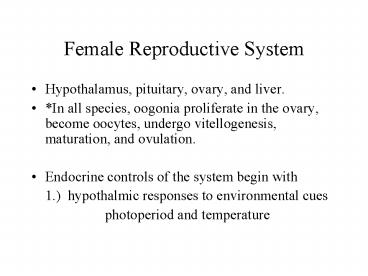Female Reproductive System - PowerPoint PPT Presentation
1 / 23
Title:
Female Reproductive System
Description:
FISH--Male/female development is regulated by genetic and hormonal control ... individuals develop first into females and turn later into males-Ex (Clown Fish) ... – PowerPoint PPT presentation
Number of Views:278
Avg rating:3.0/5.0
Title: Female Reproductive System
1
Female Reproductive System
- Hypothalamus, pituitary, ovary, and liver.
- In all species, oogonia proliferate in the
ovary, become oocytes, undergo vitellogenesis,
maturation, and ovulation. - Endocrine controls of the system begin with
- 1.) hypothalmic responses to environmental cues
- photoperiod and temperature
2
Female Reproductive System
- 2.) hypothalmic responses to proximal cues like
substrate type, courtship behaviors, and
pheromones. - Ultimately these cues influence gonadotropin
releasing hormone (GnRH) that stimulates GTH-I
and GTH-II.
3
Role of GTH-I and GTH-II
- Ovarian and testicular function is controlled by
GTH-I and GTH-II (glycoprotein heterodimers). - GTH-I/GTH-II contain a common alpha subunit and a
distinct beta subunit conceived to be FSH-and
LH-like. - GTH-I important for vitellogenesis, early
gonadal development, and elicits the production
and storage of GTH-II. - GTH-I secreted during the early phases of
ovarian development.
4
Role of GTH-II and GnRH
- GTH-II stimulates events leading to final
oocyte maturation and ovulation in females and
spermiation in males. - GTH-IIstimulated by GnRH, NE, and NPY
- inhibited by DA
- In teleosts, multiple GnRH molecules may be
expressed simultaneously with different
functions. - GnRH mRNA levels can be influenced by many
factors state of sexual maturation,
photoperiod, and sex steroids. - Indicates that GnRH is controlled by internal and
external factors.
5
Delivery of hypothalmic hormones
- How is GnRH delivered to the gonadotrophs in the
pituitary gland? - In mammals a hypothalamohypophysial portal system
is present. - In cartilaginous, salmonid fishes, and others no
portal system exists. GnRH delivered by direct
innervation of all portions of the pituitary.
6
Changes in levels of GTH-I and GTH-II in coho
salmon during reproductive maturation
GTH-II
GTH
GTH-I
M
O
N
A
A
M
S
J
J
Vitellogenesis Ovulation
Adapted from Dickoff and Swanson, 1990
7
Ovary Anatomy
- Teleost ovarian structure is classified into two
forms gymnovarian and cystovarian - Gymnovarian ovaries are possessed by most bony
fishes except (salmonids). - Lack a true ovarian cavity.
- Characterized by ovigerous folds which lie
exposed to the peritoneal cavity. - Oocytes are ovulated into the coelom and moved
into the oviduct by ciliated epithelium.
8
Ovary Anatomy
- Cystovarian ovaries (salmonids) have a true
ovarian capsule. - Oocytes are ovulated into the intraovarian space
and move down to the cloaca without entering the
peritoneal cavity by ciliated epithelium or
smooth muscles.
9
A section through a cystovarian ovary showing
ovigerous folds and location of oocytes
Adapted from Turner, 1983
10
Gymnovarian
Cystovarian
Bilobed
Bilobed
Mesonephric Kidneys
Mesonephric Kidneys
11
Follicle Anatomy
- Ovarian follicle consists of a developing oocyte
and two surrounding cells layers. - Innermost layer steroidogenic granulosa cells
Outer layer thecal layer (fibroblasts, collagen
fibers, capillaries, and steroidogen special
theca cells).
12
Diagrammatic representation of the follicle and
oocyte during early vitellogenesis
Nagahama, 1983
13
Oocyte Recruitment
- Three modes of oocyte development in teleosts
- Synchronous- all oocytes develop synchronously
and ovulate at the same time.
Ex Pacific Salmon (semelparous) - Group-synchronous- vitellogenic oocytes are
divided into groups, which ovulate over the
course of one breeding season. - Ex RBT (iteroparous)
14
Oocyte Recruitment
- Three modes of oocyte development in teleosts
- Asynchronous- oocytes at all developmental stages
are present in the ovary. - Ex Tropical fish
15
Mechanisms of Sex Determination
- I. Recombination of sex chromosomes at
fertilization - a. Chromosomal genotype
- Mammals and most fish Male XY
- FemaleXX
- Birds and some fish MaleZZ
- FemaleZW
16
Sex Determination/Development
- b. H-Y Antigen
- 1. Male specific antigen present on the
surfaces of cells - XYH-Y antigen
- Old theory suggested H-Y antigen existed in
fish--Not true - 2. Can be used to sex embryos in mammals
- 3. Does not cause male development
17
Sex Determination/Development
- SRY Gene
- Located on the Y chromosome of mammals and NOT
FISH - Stimulates male development
- Produces Testis Determining Factor (TDF)
- FISH--Male/female development is regulated by
genetic and hormonal control
18
Sex Determination/Development
- Development of the gonads, reproductive tract and
external phenotype - a. Origin of gonads
- Fish are similar to mammals in that the male and
female start with an undifferentiated gonad - Mesonephros (Primative kidney)
- Ovary and testis arise from this undifferentiated
gonad-PGC migrate from yolk sac to the genital
ridge--Mechanism is unclear in fish
19
Sex Determination/Development
- b) Origin of reproductive tract
- Two duct system
- Mullerian ducts--female reproductive
tract-oviducts, uterus, cervix and vagina - Wolffian ducts--male reproductive
tract-epididymis, vas deferens, seminal vessicles - FISH--tubular extension of the gonad
20
Mechanisms of Sex Determination
- II. Temperature-dependent sex determination
- Alligators and turtles have no heteromorphic pair
of chromosomes-sex is determined by temperature - Example-Alligators-lays 40-45 eggs (65 days to
hatch) - 93oF-All F
- 86oF-All M
- 88oF-Half F and half M
21
Mechanisms of Sex Determination
- III. Behavior sex determination
- Social situations can initiate changes in gonadal
sex. - Example-(Marine fish) Sex change is initiated by
removal or addition of dominant male or female to
a population. - Mechanism of action is unclear!
- However, GnRH-cells in the preoptic area of the
brain increase.
22
Hermaphroditism in Fish
- c. Three forms of hermaphroditism in fish
- 1. Protogynous hermaphroditism-individuals
develop first into females and turn later into
males-Ex (Clown Fish) - 2. Protandrous hermaphroditism- individuals
develop first into males and turn later into
females - -Marine fish
23
Hermaphroditism in Fish
- 3. Synchronous hermaphroditism-Both male and
female states coexist functionally - -Sea bass (self fertilization)































